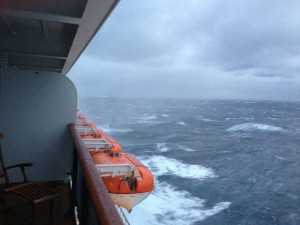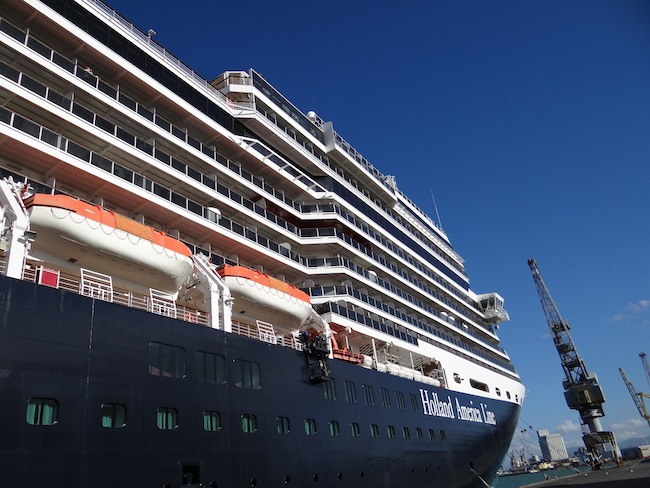Transatlantic Crossing Observations On Queen Mary 2: The Ocean in Motion and Seasickness
Winter Transatlantic Crossing. The Ocean in Motion. Seasickness Tips And Advice
This is the first in a series of articles about observations and advice for travellers about Crossing the Atlantic on the Queen Mary 2. This one is about the motion of the ocean – and tips and advice about seasickness. It was written while on a stormy winter crossing!
Here I am on the first morning of our transatlantic crossing from Southampton to New York on the stunning Cunard Queen Mary 2. I am sitting in the Grills Concierge Lounge on Deck 9 while Mark, who is travelling with me, sleeps off the effects of the seasickness injection that he had to have this morning.
The TV screen in the lounge is showing that we are in the midst of a Force 8 Gale, and the sea is classified as “very rough”. The ship overall is very quiet. So, I suspect that many others are suffering from the effects of the enthusiastic motion of the ocean that started last night. During the night and into this morning it has got steadily more choppy, and even a huge ship like the Queen Mary 2 (with its cutting edge liner shaping and stabilisers) is not a fool proof match for the rough Winter Atlantic sea. The movement of the ship is very pronounced, with the bow rising and the stern falling and vice versa in a very energetic fashion. You walk around the ship like a drunk, swaying about. It is quite amazing how much the ship moves up and down.
The big stabilisers largely stop the side to side, or corkscrew type motion, that I believe tends to be the motion that causes most people to feel seasick. This was the problem of the old liners back in the 1930s and 1940s, as they did not have this stabiliser technology
I always say that being seasick at sea now days is quite unusual. Generally it is. But taking to the sea at winter across the Atlantic is always going to be one of the tough tests of your sea legs! Not all pass the test….
However, the fear of being seasick should not put you off trying a cruise or a crossing. Though you probably should first try out a more sedate mid summer Fjords or Med cruise, the Caribbean out of hurricane season or take a summer crossing when the chance of having calmer seas is at their greatest.
The following are my tips about seasickness and how to deal with it:
- Do not psyche yourself into feeling seasick. Many people get so worried and wound up about it, they almost make it happen. There are things you can do to reduce and erase the likely causes. These are in the tips that follow.
- Book a cabin that is in the middle of the ship and low down, and try and use the public areas in the middle of the ship. This is where movement will be the least. Rough seas will cause the bow to rise and the stern to fall, and then reverse. The centre of the ship stays the most still through that movement. On this crossing our suite is at the front of the ship, and we can see and feel a lot of movement.
- Use the over-the-counter seasickness pills when going on a cruise. You should buy them from a pharmacy or drug store before you go. They are very effective. You start taking them 2 hours before you set off, and then every 8 hours. It is better to start taking them and then stop if you are feeling great, rather than waiting to feel ill before you start. For if you do end up unfortunately being physically ill you will not keep them down to get the effect! Some people use the acupressure wrist bands instead, but I have never seen anyone really be convinced or successful with them. The pills have always worked for me.
- If you still – or do – feel lousy and seasick, go as soon as you can to the medical centre and get the injection. This is very fast and effective. You will sleep for a few hours and then feel great. They often also give you pills of the same active ingredient (promethazine) to take for next few days.
- Once on a level keel, as it were, eat ginger, drink ginger ale, get fresh air and look at the horizon if you do have bouts of feeling a bit queasy.
It is better to pay the few dollars or pounds for the OTC pills before you go if you have any fears, rather than having to pay the $100 plus for the injection. Better to prevent than cure…
Do not suffer and let seasickness affect and ruin any aspect of your cruise, as there is no need to!
I, so far anyway, have been feeling fine and will keep following my advice. Mark had not followed that approach and so needed the jab. I am now off to see how his sleep is doing and I suspect I will be having lunch alone today….
(Addendum. As if to prove the power of the injection, some 3 hours after it and a long sleep, he was happily shoveling down fish and chips for lunch).
The reality is the sea moves. It is unpredictable. Always prepare for seasickness. That way, it will usually never happen.
In the next article which I will post en-route from the ship: One of the fears of every cruise line and Captain: Risk of a Norovirus Out-break





Welcome back on board! Sorry to hear Mark had a touch of seasickness, but it’s actually part of the experience of some of us! Looking forward to your blog.
Hi Gary – I’m lucky as i never get seasick (I put it down to being a Cornishman) my friends who are fisherman swear by a Bacon Sandwich to stop seasickness.
Tristan
Lucky you! I am also lucky as not been seasick (yet!). Hopefully I will keep that way… Though being seasick has never put my partner off still going…!